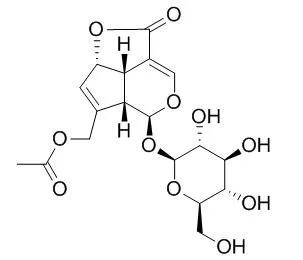| Description: |
Asperuloside exerts its anti-inflammatory effect in correlation with inhibition of a pro-inflammatory mediator through suppressing nuclear factor kappa-B (NF-κB) nuclear translocation and MAPK phosphorylation in a dose-dependent manner. Chronic administration of Asperuloside stimulates anti-obesity and anti-metabolic syndrome activity in HFD-fed rats across several organs, similar to Eucommia leaf extract (ELE) administration. |
| Targets: |
Glut | TNF-α | ERK | JNK | p38MAPK | NF-kB | IL Receptor |
| In vitro: |
| Int. Immunopharmacol., 2016 Feb;31:109-15. | | Pretreatment with the compound asperuloside decreases acute lung injury via inhibiting MAPK and NF-κB signaling in a murine model.[Pubmed: 26710167 ] | Asperuloside, an iridoid glycoside found in Herba Paederiae, is a component from traditional Chinese herbal medicine.
METHODS AND RESULTS:
In this study, we aimed to investigate the protective effects and potential mechanisms of Asperuloside action on inflammatory responses in lipopolysaccharide (LPS)-stimulated Raw 264.7 cells and an LPS-induced lung injury model. The pro-inflammatory cytokines and signaling pathways were measured by enzyme-linked immunosorbent assays (ELISA) and Western blotting to determine the effects of Asperuloside. We found that Asperuloside can significantly downregulate tumor necrosis factor alpha (TNF-α), interleukin (IL)-1β, and IL-6 levels in vitro and in vivo, and treatment with Asperuloside significantly reduced the lung wet-to-dry weight, histological alterations and myeloperoxidase activity in a murine model of LPS-induced acute lung injury (ALI). In addition, Western blot analysis that pretreatment with Asperuloside remarkably blunted the phosphorylation of inhibitor of nuclear factor kappa-B (IκBα), extracellular signal-related kinases 1 and 2 (ERK1/2), c-Jun. N-terminal kinase (JNK) and p38 mitogen-activated protein kinase (p38MAPK) in LPS-stimulated inflammation.
CONCLUSIONS:
These results indicate that Asperuloside exerts its anti-inflammatory effect in correlation with inhibition of a pro-inflammatory mediator through suppressing nuclear factor kappa-B (NF-κB) nuclear translocation and MAPK phosphorylation in a dose-dependent manner. | | Int J Mol Sci . 2018 Jul 12;19(7):2027. | | Asperuloside and Asperulosidic Acid Exert an Anti-Inflammatory Effect via Suppression of the NF-κB and MAPK Signaling Pathways in LPS-Induced RAW 264.7 Macrophages[Pubmed: 30002289 ] | | Abstract
Hedyotis diffusa is a folk herb that is used for treating inflammation-related diseases in Asia. Previous studies have found that iridoids in H. diffusa play an important role in its anti-inflammatory activity. This study aimed to investigate the anti-inflammatory effect and potential mechanism of five iridoids (Asperuloside (ASP), asperulosidic acid (ASPA), desacetyl asperulosidic acid (DAA), scandoside methyl ester (SME), and E-6-O-p-coumaroyl scandoside methyl ester (CSME)) that are presented in H. diffusa using lipopolysaccharide (LPS)-induced RAW 264.7 cells. ASP and ASPA significantly decreased the production of nitric oxide (NO), prostaglandin E₂ (PGE₂), tumor necrosis factor-α (TNF-α), and interleukin-6 (IL-6) in parallel with the inhibition of inducible nitric oxide synthase (iNOS), cyclooxygenase-2 (COX-2), TNF-α, and IL-6 mRNA expression in LPS-induced RAW 264.7 cells. ASP treatment suppressed the phosphorylation of the inhibitors of nuclear factor-kappaB alpha (IκB-α), p38, extracellular signal-regulated kinase (ERK), and c-Jun N-terminal kinase (JNK). The inhibitory effect of ASPA was similar to that of ASP, except for p38 phosphorylation. In summary, the anti-inflammatory effects of ASP and ASPA are related to the inhibition of inflammatory cytokines and mediators via suppression of the NF-κB and mitogen-activated protein kinase (MAPK) signaling pathways, which provides scientific evidence for the potential application of H. diffusa.
Keywords: anti-inflammation; iridoids; mitogen-activated protein kinase; nuclear factor-kappaB. |
|
| In vivo: |
| J Nutr Sci. 2012 Sep 5;1:e10. | | Asperuloside stimulates metabolic function in rats across several organs under high-fat diet conditions, acting like the major ingredient of Eucommia leaves with anti-obesity activity.[Pubmed: 25191539] | Eucommia leaves (Eucommia ulmoides Oliver) contain chlorogenic acid (a caffeic acid derivative) and geniposidic acid and Asperuloside (ASP), iridoid glucosides used in beverages.
METHODS AND RESULTS:
We used a metabolic syndrome rat model, produced by feeding a 35 % high-fat diet (HFD), to examine potential anti-obesity and anti-metabolic syndrome effects and mechanisms of chronic administration of ASP. These effects were compared with Eucommia leaf extract (ELE), the positive control, which exhibits anti-obesity effects. A total of six rats were studied for 3 months in five groups. ASP suppressed body weight, visceral fat weight, food intake and circulating levels of glucose, insulin and lipids, and increased the plasma adiponectin level in rats on a HFD. These effects are similar to those of ELE, except for the influence on the plasma glucose level. RT-PCR studies showed that ASP (like ELE with known anti-obesity effects) diminished isocitrate dehydrogenase 3α, NADH dehydrogenase flavoprotein 1 (Comp I) mRNA and fatty acid synthase levels (white adipose tissue), increased carnitine palmitoyltransferase 1α and acyl-CoA dehydrogenase, very-long-chain mRNA levels (liver), and increased Glut4, citrate synthase, isocitrate dehydrogenase 3α, succinyl CoA synthase, peroxisomal 3-ketoacyl-CoA thiolase, dihydrolipoamide succinyl transferase and succinate dehydrogenase mRNA levels (skeletal muscle) under HFD conditions. Interestingly, ASP administration resulted in significantly increased mRNA levels of uncoupling protein 1 (UCP1) in the brown adipose tissue of HFD-fed rats; ELE did not affect the expression of UCP1. The increased expression of UCP1 may be negated by many ingredients other than ASP in the ELE.
CONCLUSIONS:
These findings suggest that chronic administration of ASP stimulates anti-obesity and anti-metabolic syndrome activity in HFD-fed rats across several organs, similar to ELE administration; thus, ASP may be an important ingredient of ELE. |
|






 Cell. 2018 Jan 11;172(1-2):249-261.e12. doi: 10.1016/j.cell.2017.12.019.IF=36.216(2019)
Cell. 2018 Jan 11;172(1-2):249-261.e12. doi: 10.1016/j.cell.2017.12.019.IF=36.216(2019) Cell Metab. 2020 Mar 3;31(3):534-548.e5. doi: 10.1016/j.cmet.2020.01.002.IF=22.415(2019)
Cell Metab. 2020 Mar 3;31(3):534-548.e5. doi: 10.1016/j.cmet.2020.01.002.IF=22.415(2019) Mol Cell. 2017 Nov 16;68(4):673-685.e6. doi: 10.1016/j.molcel.2017.10.022.IF=14.548(2019)
Mol Cell. 2017 Nov 16;68(4):673-685.e6. doi: 10.1016/j.molcel.2017.10.022.IF=14.548(2019)